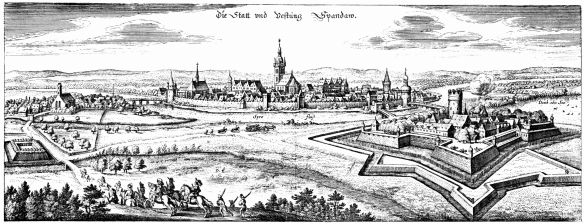
Spandau Citadel (Merian, 1633)
The three major states of the Empire were rarely in a condition to give a lead in engineering matters. Brandenburg-Prussia was already one of the prominent powers of north Germany, yet its engineers displayed little skill or originality until the middle of the eighteenth century. Bastion fortification first came to Brandenburg in 1537, when Margrave Johann commissioned an unknown Italian to fortify Küstrin on the Oder. The citadel of Spandau, another essay in the same style, was designed in 1559 by the Italian Giromela and the native master Christoph Romer. In 1602 we hear for the first time of a Dutch engineer, in the person of one Nicolas de Kemp. The Netherlandish fortification rapidly supplanted the Italian, and the new works that were carried out in the duchy of East Prussia, which was acquired in 1618, were all executed in the new style. The foremost examples were the earthen enceintes of Konigsberg and Pillau, which were begun in 1626. The leading native exponent of Netherlandish fortification was Matthias Dogen, who learnt the manner while he was serving as the Brandenburg resident in The Hague. His massive treatise Heutiges Tages Obliche Kriegs Baukunst was published in German and Latin in 1646 and 1647, and in French in 1648.
That most formidable ruler the Great Elector Frederick William (1640-88) called on the services of Dogen to help him to carry out a comprehensive scheme of national defence. Berlin, which had been girdled with an enceinte as recently as 1624, was refortified from 1658 according to the designs of Dogen, with contributions thrown in by Field Marshal Sparr and the Great Elector himself. Fortification work was in progress at the same time at Lippstadt, Kolberg, Magdeburg, and at Konigsberg, where the Great Elector had crushed civil liberties and was in the process of building the citadel of Friedrichsburg to overawe the townspeople.
Prussian officers went forth to help Peter the Great of Russia and his immediate successors in their sieges and fortress-building, which is one of the few instances in which we find that German experts were numerous and well-qualified enough to be in a position to help foreigners. The Prussians got on much less well with the Dutch, when they were allies in the War of the Spanish Succession. The Prussian officers were inclined to be patronising and boastful, and their gunners were such careless shots that the cannon-balls used to fly right over the besieged fortresses and land in the Dutch trenches on the far side.